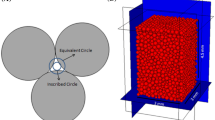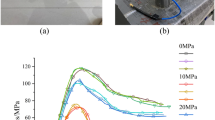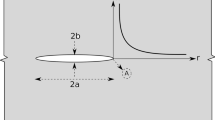Abstract
A unified permeability evolution model is proposed to capture the evolution of permeability induced by stress. This model is formulated within a conventional permeability–porosity power function, with special attentions being paid to the effects of shear deformation-induced tortuosity and compaction-induced closure of fissures through a permeability resistance parameter. This model contains a small amount number of parameters, which can be calibrated based on conventional experiments. The proposed model is validated through comparison between model simulation and experimental results for sandstones under a wide range of confining pressures. Good performance demonstrates the capability of the proposed permeability evolution model.







Similar content being viewed by others
References
Bernabé Y (1991) Pore geometry and pressure dependence of the transport properties in sandstones. Geophysics 56:436–446
Bernabé Y, Mok U, Evans B (2003) Permeability-porosity relationships in rocks subjected to various evolution processes. Pure appl Geophys 160:937–960
Bernabé Y, Li M, Maineult A (2010) Permeability and pore connectivity: a new model based on network simulations. J Geophys Res 115:B10203
Bouteca MJ, Sarda JP, Vincke O (2000) Constitutive law for permeability evolution of sandstones during depletion. In: Proceedings of the SPE international symposium on formation damage control, Lafayette, LA, USA, pp 81–86
Cheng-Haw L, Chen-Chang L, Bih-Shan L (2007) The estimation of dispersion behavior in discrete fractured networks of andesite in Lan-Yu Island, Taiwan. Environ Geol 52:1297–1306
Crawford BR, Yale DP (2002) Constitutive modeling of deformation and permeability: relationships between critical state and micromechanics. In: Proceedings of the SPE/ISRM rock mechanics in petroleum engineering conference, Irvint, Texas, 2002. Society of Petroleum Engineers of AIME (SPE), pp 288–297
David C, Wong T-F, Zhu W, Zhang J (1994) Laboratory measurement of compaction-induced permeability change in porous rocks: implications for the generation and maintenance of pore pressure excess in the crust. Pure appl Geophys 143:425–456
Friedman M (1977) Porosity, permeability, and rock mechanics—a review. In: Proceedings of 17th symposium on rock mechanics, preparation, site characteristics, Snowbird, UT, USA
Gessner K (2009) Coupled models of brittle-plastic deformation and fluid flow: approaches, methods, and application to mesoproterozoic mineralisation at mount Isa, Australia. Surv Geophys 30:211–232
Lade PV, Kim MK (1995) Single hardening constitutive model for soil, rock and concrete. Int J Solids Struct 32:1963–1978
Ma J (2014) Coupled flow deformation analysis of fractured porous media subject to elasto-plastic damage. Ph.D Thesis, The University of New South Wales, Australia
Main IG, Kwon O, Ngwenya BT, Elphick SC (2000) Fault sealing during deformation-band growth in porous sandstone. Geology 28:1131–1134
Morris JP, Lomov IN, Glenn LA (2003) A constitutive model for stress-induced permeability and porosity evolution of Berea sandstone. J Geophys Res 108:2485
Ngwenya BT, Kwon O, Elphick SC, Main IG (2003) Permeability evolution during progressive development of deformation bands in porous sandstones. J Geophys Res 108:2343
Pan JB, Lee CC, Lee CH, Yeh HF, Lin HI (2010) Application of fracture network model with crack permeability tensor on flow and transport in fractured rock. Eng Geol 116:166–177
Pride SR, Berryman JG (1998) Connecting theory to experiment in poroelasticity. J Mech Phys Solids 46:719–747
Rice JR (1992) Fault stress states, pore pressure distributions, and the weakness of the San Andreas fault. Fault Mech Transp Prop Rocks 51:475–503
Rudnicki JW (2001) Coupled deformation–diffusion effects in the mechanics of faulting and failure of geomaterials. Appl Mech Rev 54:483–502
Scott DC (2001) An assessment of reasonable tortuosity values. Pharm Res 18:1797–1800
Vajdova V, Baud P, Wong T-F (2004) Permeability evolution during localized deformation in Bentheim sandstone. J Geophys Res 109:B10406
Yale DP (2002) Coupled geomechanics-fluid flow modeling: effects of plasticity and permeability alteration. SPE/ISRM rock mechanics conference, 20–23 October 2002, Irving, Texas
Zhu W, Wong TF (1996) Permeability reduction in a dilating rock: network modeling of damage and tortuosity. Geophys Res Lett 23:3099–3102
Zhu W, Wong TF (1997) The transition from brittle faulting to cataclastic flow: permeability evolution. J Geophys Res B Solid Earth 102:3027–3041
Zhu W, Wong TF (1999) Network modeling of the evolution of permeability and dilatancy in compact rock. J Geophys Res B Solid Earth 104:2963–2971
Zhu W, David C, Teng-Fong W (1995) Network modeling of permeability evolution during cementation and hot isostatic pressing. J Geophys Res 100:15451–415464
Zhu W, Montési LGJ, T-f Wong (2007) A probabilistic damage model of stress-induced permeability anisotropy during cataclastic flow. J Geophys Res 112:B10207
Zoback MD, Byerlee JD (1975) The effect of microcrack dilatancy on the permeability of Westerly granite. J Geophys Res 80:752–755
Acknowledgments
Authors thank Dr. Gaofeng Zhao for his constructive comments and review of this manuscript. Authors’ acknowledgement is also given to the anonymous reviewer for his/her valuable comments and suggestions. This work is supported by the National Nature Science Foundation of China (No. 51278383, No. 51238009 and No. 51025827), Key Scientific and Technological Innovation Team of Zhejiang province (No. 2011R50020), Key Scientific and Technological Innovation Team of Wenzhou (No. C20120006). These financial supports are gratefully acknowledged.
Author information
Authors and Affiliations
Corresponding author
Rights and permissions
About this article
Cite this article
Ma, J., Wang, J. A Stress-Induced Permeability Evolution Model for Fissured Porous Media. Rock Mech Rock Eng 49, 477–485 (2016). https://doi.org/10.1007/s00603-015-0760-8
Received:
Accepted:
Published:
Issue Date:
DOI: https://doi.org/10.1007/s00603-015-0760-8




